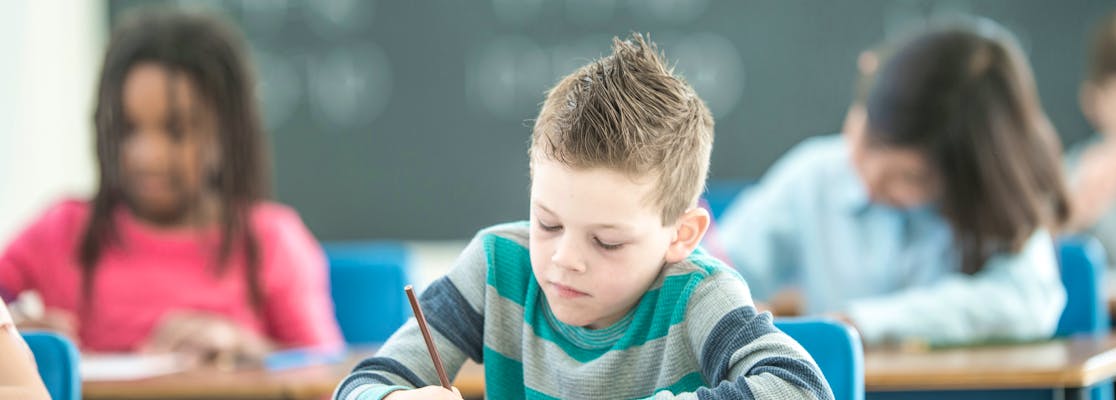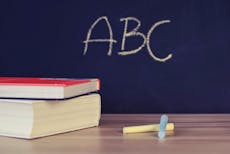A Study Guide to the MAP Test Grade 3: with Tips
All products and services featured are independently selected by WikiJob. When you register or purchase through links on this page, we may earn a commission.
- What Is the 3rd Grade MAP Test?
- The Three Core Sections of the 3rd Grade MAP Test
empty
empty
empty
- 3rd Grade MAP Test Practice Questions
empty
empty
empty
- What Is an Adaptive Test?
- How to Help Students Prepare for the MAP Test Grade 3
empty
- Why Should Students Prepare for the MAP Test Grade 3?
- Frequently Asked Questions
- Final Thoughts
The 3rd grade MAP (Measurement of Academic Progress) test is used to measure a student’s abilities in math, language usage and reading on a grade level. This computerized adaptive test identifies current skills, areas for improvement and can be used as entry to special educational programs.
For more information on how the MAP test is scored, see our dedicated article.
What Is the 3rd Grade MAP Test?
The MAP test is a computer-generated test designed to measure a student's academic progress during the school year.
Developed by NWEA, it is based on the Common Core Curriculum adopted by the majority of US schools.
The grade 3 MAP growth test is administered to children between the ages of 8 and 9 years. It is divided into three subjects: math, language usage and reading.
The test is used by teachers and parents to gain a better understanding of a student’s progress during the course of the 3rd grade.
It also provides details about how a student can be instructed to improve their academic progress.
The MAP test is often used to determine whether or not a student needs to be added to a special or gifted education program.
More information on each specific NWEA MAP test level can be found in our dedicated articles:
Take a Practice Test for the 3rd Grade Map on TestPrep-Online
The Three Core Sections of the 3rd Grade MAP Test
There are three core sections of the MAP Test Grade 3.
The test is untimed, but each section takes between 45 to 60 minutes to complete.
Each of these sections is divided into further areas. These are the sections and the areas each covers.
3rd Grade MAP Math
There are four general areas that are covered by this section:
- Numbers and operations – Mental math calculations
- Geometry – Shapes, symmetry and parallel lines
- Operations and algebraic thinking – Fractions and decimals
- Algebra – Solving equations
Most questions on the test will not require the student to use a calculator. If a calculator is needed, it appears on screen.
They are fairly simple; the most complex questions will involve mental arithmetic skills.
Students also have the use of scratch paper and pencil for workings.
There are normally 47 to 53 questions in this section. The total number changes because of the adaptive nature of the test.
3rd Grade MAP Language Usage
There are normally 50 to 53 questions in this section which focuses on these areas:
- Language – Language conventions, including spelling, punctuation and grammar
- Writing conventions – Planning and organizing writing
- Grammar usage – Applying grammar conventions
3rd Grade MAP Reading
The reading section for the third grade is written so third graders are generally capable of answering them.
It is divided into three sections:
- Word recognition and vocabulary – Decoding words, structures and relationships between words
- Literature – Understanding structural devices and describing key ideas in a text
- Informational texts – Understanding main ideas and structures
There are generally around 40 to 43 questions in the reading section.
3rd Grade MAP Test Practice Questions
Here are some 3rd grade MAP test practice questions to try.
3rd Grade MAP Test Practice Questions – Math
1. Which number is missing from this sequence?
35 | 28 | 21 | ___ | 7
a) 17
b) 14
c) 22
d) 11
2. To bake a cake, Tom needs 3 cups of flour and 1 cup of milk. How many cups of flour will he need to bake 3 cakes?
a) 1
b) 3
c) 6
d) 9
1. Complete the sentence by choosing the correct word.
Amelia didn’t know _______ she should take an umbrella.
a) Weather
b) Whether
c) Wether
d) Wetter
2. Which sentence is written correctly?
a) It was passed eight o’clock in the evening.
b) I had, apples oranges, and even, limes, in my basket.
c) It had been a really lovely day at the park.
d) I didn’t no what to do about it.
1. As the wind whispered through the leaves, young Ethan stood before the towering tree, his heart racing with fear. Determined to conquer his fear of heights, he took a deep breath and began his ascent. Each step brought him closer to the canopy, where bravery awaited. With trembling hands, he grasped the branches, pushing past his doubts. Higher he climbed, until finally, he reached the top. As he looked down, a sense of triumph washed over him. From that day forward, Ethan's fear of heights transformed into an unwavering belief in his ability to overcome any challenge that stood in his way.
What was the main character's motivation for wanting to climb the tree in the first place?
a) The main character wanted to prove to himself that he wasn't afraid of heights.
b) The main character wanted to see how high he could climb.
c) The main character wanted to rescue a cat that was stuck in the tree.
d) The main character wanted to retrieve a kite that was stuck in the tree.
2. What does the word 'consequence' mean in the following sentence?
Skipping school can have serious consequences, such as falling behind in schoolwork and getting into trouble with parents or teachers.
a) Something that is certain to happen
b) A reward for good behavior
c) A positive outcome
d) A result or effect of an action
What Is an Adaptive Test?
The NWEA MAP test is known as an adaptive test.
This is a style of computerized test where the next question to be asked is based on the student’s response.
If a question is answered correctly, the following question will be slightly more difficult. If they don't get the previous question right, then a simpler one is presented next.
This means it is possible that no two students experience exactly the same test.
Additionally, it allows students to showcase their skill level and abilities in the subject.

If you want 12-month access to all the practice resources for this test, our partner TestPrep-Online.com offers a Family Membership.
Family Membership gives you access to all the TestPrep-Online resources for the next 12 months. You will also get two separate accounts, which can be very helpful if you have two children preparing for their tests.
Get a Family Membership with 12-month access
How to Help Students Prepare for the MAP Test Grade 3
The NWEA MAP test is an increasingly popular way of testing academic knowledge.
There are many ways that you can help your child improve their 3rd grade MAP scores.
Before Test Day
Start preparation in advance by following the tips below. This will help your child feel less daunted by the test:
Step 1. Create a Study Plan
Make a plan to help your child practice each of the sections. Following a study plan allows them to cover the entire test, and you can find out their current strengths and weaknesses.
Step 2. Practice
Practicing MAP sample tests lets your child familiarize themselves with the style of questions. It also helps them learn techniques for approaching different types of question.
Step 3. Review Current Skills
It is important to just cover your child’s existing knowledge. Learning lots of new skills will not help your child pass tests; it could cause upset and confusion.
Step 4. Stick to a Routine
While it might be tempting to throw out regular activities, this can be a mistake. It can often cause mental confusion in children, so stick to your life routines as much as possible.
Step 5. Motivation
Keep your child motivated throughout the day with regular rewards, positive interactions and encouragement. This helps keep them interested in studying.
Step 6. Positivity
Those who are positive are more likely to engage in active learning. Encouraging a positive attitude and creating a fun environment also helps take away the stress of the exam situation.
Step 7. Rest
Ensure your child gets all the rest they need. During grade 3 they should be having about 9 to 11 hours of sleep a night for optimum functioning.
Step 8. Good diet
Stick to a good diet during the revision period. Provide lots of healthy snacks like fruit and vegetable sticks. Eating healthily can help their brain function at its best.
On Test Day
Here are some tips for making sure your child does well on the day of their 3rd grade MAP test:
-
Dress appropriately – Some testing locations could be cold, others could be hot. Dress your child in layers so they can adjust their clothing and feel more comfortable in the test room.
-
Reward – Provide a reward to children for taking part in the test. It doesn’t matter what the result is, always provide a reward to praise them for taking part and doing their best.
-
Provide snacks – Children can lose concentration if they haven’t eaten enough during the day. On the day of the test, ensure they’ve had a good breakfast and have plenty of healthy snacks – though don’t overfeed, as being too full can cause a problem, too.
-
Drink plenty of fluids – Encourage them to drink water. Water or sugar-free juices are the best options. Sugary sodas should be avoided.
-
Be early – Get your child to the testing location in plenty of time so they can prepare for the test. Being late can cause anxiety and stress, which could negatively impact their performance.
Why Should Students Prepare for the MAP Test Grade 3?
There are numerous reasons why students should be prepared. These include the following:
- It helps develop your child’s competitive edge and encourages them to do well.
- The academic career of your child may be determined by the test results.
- It sets a good foundation for the future, showing them the importance of learning and tests.
Your child may sit the 3rd grade MAP test during the academic year or as part of an admissions test.
Familiarity with the style of the test helps alleviate anxiety and gives them an advantage which can help boost performance.
Frequently Asked Questions
The 3rd grade MAP (Measures of Academic Progress) test is a standardized test used to measure a student's academic progress in math, reading, and language usage.
The test is computer-adaptive, meaning that the difficulty of the questions adjusts to the student's performance level.
It is often used by schools to identify areas where a student may need additional support or enrichment, and to track their progress over time.
The 3rd grade MAP test is not designed to be a pass or fail test.
Instead, it is used to provide educators with information about a student's academic progress, so that they can better support and guide their learning.
How challenging the test is depends on a variety of factors, such as individual academic strengths and weaknesses, prior preparation, and confidence in test-taking.
There are various websites that offer free and paid sample NWEA 3rd grade practice test questions. TestPrep-Online has a range of materials that can help you prepare for the MAP test.
On TestPrep-Online, you can try practice quizzes and a full-length test simulation. This gives your child a good understanding of what to expect on test day.
The number of questions on the MAP test for 3rd grade can vary, as the test is computer-adaptive.
Typically, the MAP test for 3rd grade includes a range of 40 to 50 questions in each section: math, reading, and language usage.
The MAP test for 3rd grade is not timed, meaning that students can take as much time as they need to answer each question to the best of their ability.
Typically, each section takes between 45 to 60 minutes to complete. Sections can be administered in one sitting or separately.
3rd Grade MAP testing practice samples can be found at TestPrep-Online.
There are free and premium versions available to help support your child in preparing for their MAP test.
Check with your child’s school to find out whether the 3rd grade MAP test is optional or mandatory.
The 3rd grade MAP testing scores are just one measure of your child’s skills and abilities. They are a useful tool in identifying areas of strength and weakness to inform future learning.
The MAP test for 3rd grade, like all MAP tests, is designed to measure a student's academic progress in math, reading, and language usage.
The primary purpose of the MAP test is to help educators identify areas where students may need additional support or enrichment, and to provide data to guide instructional decisions.
The 3rd grade NWEA scores are used as a benchmark to compare with future test results.
Whether or not you can retake the 3rd grade MAP test depends on your child’s school.
If you feel your child was unable to perform at their best for any reason, it is best to speak with the class teacher.
A complete study guide for the MAP test in 3rd grade can be found on TestPrep-Online.
Here, you can find free sample NWEA 3rd grade practice test questions and other resources to help your child perform at their best.
Final Thoughts
The MAP Test for grade three is one of the most important tests that can be taken at this age.
Not only does it determine the future educational path of the students, it can be their first experience of taking a real test.
Doing well on the 3rd grade MAP test can help to instill a spirit of learning. This can then be carried forward into future tests.
Preparing for the MAP test in grade 3 can feel like a daunting task, but with the right study strategies and tips, you can help your child feel confident and ready to tackle the test.








